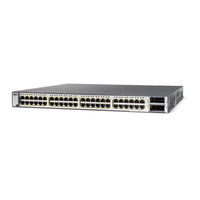Cisco Catalyst3560-E Switch Manuals
Manuals and User Guides for Cisco Catalyst3560-E Switch. We have 1 Cisco Catalyst3560-E Switch manual available for free PDF download: Software Configuration Manual
Cisco Catalyst3560-E Software Configuration Manual (1414 pages)
Table of Contents
-
Booting Manually115
-
Event Service125
-
Namespace Mapper125
-
-
-
IP Addresses183
-
Hostnames183
-
LRE Profiles186
-
-
-
Configuring NTP192
-
Radius Operation247
-
Configuring SSH274
-
Ciphersuites279
-
X Host Mode296
-
Mac Move297
-
Host Detection354
-
Session Creation355
-
Interface Types371
-
Switch Ports372
-
Routed Ports374
-
Supported Vlans414
-
Token Ring Vlans417
-
Deleting a Vlan421
-
Displaying Vlans426
-
Configuring Vmps437
-
The Vtp Domain446
-
Vtp Modes447
-
Vtp Version 2448
-
Vtp Version 3449
-
Vtp Pruning450
-
Monitoring Vtp461
-
System Mtu489
-
Configuring Stp503
-
Stp Overview504
-
Disabled State509
-
Forwarding State509
-
Learning State509
-
Listening State509
-
Configuring Mstp527
-
Hop Count531
-
Boundary Ports532
-
Topology Changes539
-
How Csuf Works560
-
Flex Links575
-
Dhcp Relay Agent590
-
Dhcp Server590
-
Dhcp Snooping590
-
Igmp Versions637
-
Immediate Leave640
-
Configuring Mvr654
-
Mld Messages667
-
Mld Queries667
-
Mld Reports668
-
Configuring Cdp697
-
Enabling Lldp708
-
Local Span724
-
Remote Span725
-
Span Sessions726
-
Destination Port730
-
Vlan Filtering730
-
Snmp Versions778
-
Snmp Examples794
-
Event Detectors799
-
Supported Acls806
-
Extended Acls829
-
Numbered Acls829
-
Named Acls830
-
Acl Logging831
-
Configuring Qos855
-
Basic Qos Model858
-
Policing on Svis865
-
Mapping Tables867
-
Types of Routing980
-
Default Gateway990
-
Configuring Rip998
-
Configuring Ospf1004
-
Configuring Eigrp1014
-
Monitoring Ospf1014
-
Eigrp Stub Routing1021
-
Configuring Bgp1022
-
Enabling Bgp Routing1027
-
Configuring Vrfs1057
-
Enabling Pbr1078
-
Understanding Ipv61085
-
Ipv6 Addresses1086
-
Neighbor Discovery1088
-
Configuring Ipv61094
-
Displaying Ipv61111
-
Hsrp Versions1115
-
Multiple Hsrp1116
-
Enabling Hsrp1118
-
Configuring Mhsrp1122
-
Understanding Wccp1156
-
Md5 Security1157
-
Wccp Negotiation1157
-
Configuring Wccp1159
-
Igmp Version 11167
-
Igmp Version 21167
-
Understanding Igmp1167
-
Pim Modes1168
-
Understanding Pim1168
-
Igmp Helper1170
-
Understanding Cgmp1173
-
Understanding Dvmrp1173
-
Monitoring Ssm1181
-
Ssm Mapping Overview1182
-
Msdp Operation1230
-
Msdp Benefits1231
-
Troubleshooting1259
-
Executing Ping1273
-
Understanding Ping1273
-
Using Ping1273
-
Usage Guidelines1275
-
Using Ip Traceroute1276
-
Understanding Tdr1277
-
Using Tdr1277
-
Using Debug Commands1278
-
Configuring Obfl1284
-
Understanding Obfl1284
-
Mib List1299
-
Supported Mibs1299
-
Copying Files1307
-
Deleting Files1308
-
Access Control Lists1343
-
Archive Commands1344
-
Arp Commands1344
-
Boot Loader Commands1344
-
Debug Commands1345
-
Fallback Bridging1346
-
Interface Commands1348
-
Ip Multicast Routing1349
-
Ip Unicast Routing1350
-
Mac Address Commands1352
-
Netflow Commands1353
-
Spanning Tree1355
-
Advertisement
